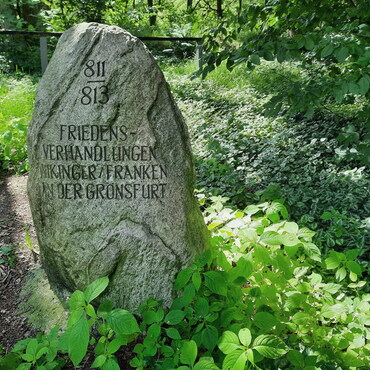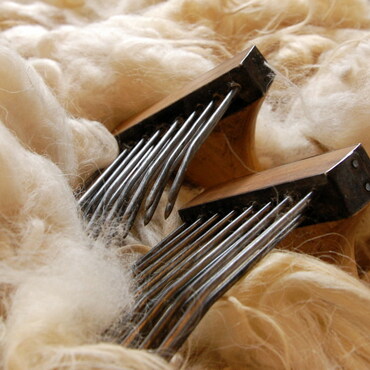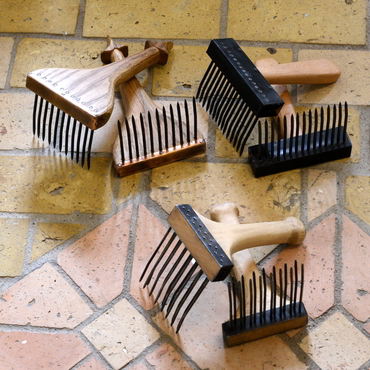Ribe was nothing like the other markets. Even though Trelleborg had some reconstructed houses and even though in some of those there were people breathing some life into them, they were located at the edge of the market. Not only were there more and bigger houses in Ribe, they were more dispersed, too. With all the tents in between, it became a balance between mobile and immobile homes and everything seemed to be a part of one another.
We went there during the "Warrior week" and saw many friends from Trelleborg and Mudgård again. Many fighters didn't sleep in their tents but occupied longhouses. Since the main focus lay on fighting, the market part was comparatively small i.e. there wasn't much for "shopping". But of course we don't go to markets in order to spend money but for the experience of being there, being a part of everything. And this is a feeling we definitely got in Ribe.
Real Re-enactment
The Ribe Vikingecenter is also known for its experimental archaeology. The houses at the site are all built in a slightly different manner, be it as a grub hut, a thatch-roofed house with daub-and-wattle walls, a house entirely made of timber or a longhouse with great wooden poles and beams supporting a great roof covered with shingles. This year's project is a small church on the other side of the "harbour" (which really is just a jetty leading out into a pond). There was a bronze bell which had been manufactured in Hedeby using Viking Age methods and which had traveled all the way from there to Ribe by cart and boat. It was to be installed at the church, calling the flocks to mass. If it made it this far, that is...
The bell was the object of dispute among the warriors. There were the jarl's followers who wanted nothing more than bring it safely to the church. There were those opposing the use of bells in the Christian ceremony - the only way to praise God was with one's own voice! There were pirates who wanted to steal it because it was of value. There were even followers of the king and the king himself - splendidly dressed! - who doubted that it was such a good idea of converting the whole town of Ripa and thereby abandoning old traditions.
This was the set that guided the fighting shows thematically. Conversion to Christianity, forced from above, one religion versus the other. And suddenly, if you act out your position, you see yourself in another situation. Today, we know about many bad things that happened in the church's name during the last centuries. People didn't know this back then. Why would you not officially forsake your gods in favour of this new one who went through ultimate suffering but in the end was revived? If you let yourself be baptized, you are promised to get a new shirt (and this was really something in those times) and eternal happiness if you follow the ways of Christ. If you are a merchant, you would be able to trade with the merchants from the Frankish Empire with all their luxury goods, eventually even the whole market town would flourish. Life would not only be better for you, but also for your children and your children's children. And just to be sure, you can still make the odd offering to the Old Gods if no one notices...
Seriously, one suddenly sees oneself equipped with fewer arguments when the situation is viewed from the historical perspective. And there was another element that became clearer to us: the need to mark out your position. In a society where there's no question of one believe versus the other, it is not necessary to state your personal believe with any symbolism. But once there is a "Them and us", you want to make clear that you are NOT one of "them". Ása noticed that one morning when a priest sat on the other side of the table during the morning meeting. She didn't wear her apron dress with the crescent and the wooden Þór's hammer. The priest had made a comment on Vil and his Þór's hammer pendant just before she arrived (something about heathens or unbelievers or something), but he did not comment on her, assuming that she must be a faithful Christian woman since she didn't have any heathen symbols on her. She then felt the need to display her way more openly. Interestingly enough, this is exactly what happened in Sweden during the conversion to Christianity: The frequency of religious symbols, be it heathen or Christian, increased. This is real re-enactment!
The Danish summer frightens us not!
Naturally it wasn't all sunshine in Ribe. At some point it rained so much that our fireplace looked more like a foot bath filled with charcoal and ashes. We were warned beforehand to dig trenches and the water drained quickly enough that we didn't experience another Mudgård. On other days the wind blew so hard that there was not even one calm moment to have. Most of the time however, the weather wasn't that bad (or we had gotten used to the Danish summer, who knows), the bats drew their circles in the evenings and the sun dried our things eventually.
We couldn't bear leaving with all the warrior groups on Sunday and Monday, we liked Ribe too much. That's why we simply stayed for another couple of days. With most people gone and not so many filling the blank spots, it was a very quiet time. Our last evening we spent with some people in the big guest house, talking and telling stories, sharing a fire and some cookies. Then, finally, it was time to go home.
Résumé
We aren't warriors. We didn't occupy ourselves with any fighting, except when we watched the competitions. We aren't part of a large group with a renowned name or something. But nevertheless we were welcomed with open arms, invited to and reminded of the social gatherings in the night ("parties"). This didn't feel like it was something exceptional, like it was a high privilege. It seemed to be just the way it was. If you don't isolate yourself from the market community, if you do your "bimling", talk to the people and perhaps share some beer/mead and humor with them, then it magically works out fine. The "above" and "below" in the social hierarchy only existed during public displays like the daily Þing where the Jarl spoke the law, it didn't even seem to exist in the people's minds (and if it did, they were wise to keep their mouths shut). It was likely to be Jante's Law at work in Scandinavia - but we didn't care. It was great. The whole Denmark tour was great.



